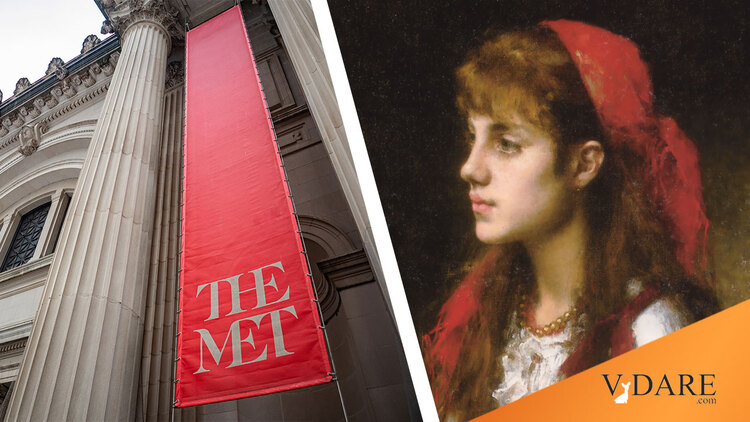
The De-Russianification Of Art
03/20/2023
Earlier: Russophobia: Russian Retards Banned From Paralympics, And Russian Cats Cancelled
From The Guardian:
As the Met reclassifies Russian art as Ukrainian, not everyone is convinced
New York museum is among institutions reattributing works by painters born in what is now Ukraine — to a mixed response
Edward Helmore in New York
Sun 19 Mar 2023 05.00 EDTQuestions of attribution are constantly under review by art scholars, but rarely are they so topical or heated as institutional efforts underway in the US and in Europe to reclassify art once described as Russian as Ukrainian.
In New York, the Metropolitan Museum of Art has quietly changed the name of an 1899 painting by the French impressionist Edgar Degas from Russian Dancer to Dancer in Ukrainian Dress.
It’s dumb to change the title of paintings because then there’s a disconnection from 123 years of written references to Degas’s Russian Dancer.
It’s like when they washed all the soot off Rembrandt’s famous Night Watch and then they got worried about whether it was set in the night or not: Should we change the name?
No, of course not. Night Watch is what the world has called it for hundreds of years. Stick with it.
It’s like when Datsun was the #2 Japanese carmaker, but then they changed their brand name to Nissan for some stupid reason, and during the decade they devoted to re-marketing their new name rather than to building better cars, they got passed up by Honda.
The Met also holds works by Arkhyp Kuindzhi and Ilya Repin, a 19th-century painter who was born in what is now Ukraine. The artists were previously listed as Russian and are now categorized as Ukrainian.
But seascape painter Ivan Aivazovsky, whom the Met had also changed from Russian to Ukrainian, was abruptly relisted as Armenian on Thursday, after an outcry from New York’s Armenian community.
Changing national attributions of painters isn’t as dumb as changing the name of paintings because the name isn’t lost. Although if they change the name’s spelling from Russian to Ukrainian, lots of people will lose the thread. So don’t do that.
In general, nationalist attributions often don’t work cleanly for subjects of multinational empires, especially for painters who work in a universal language of art.
For writers, in contrast, their language is crucial for identifying them: e.g., Conrad was born in what’s now Ukraine in the Russian Empire, but nobody calls him either a Ukrainian or Russian writer. He grew up speaking Polish and became famous writing in English. Is Conrad Polish? Yes. Is he a major figure of English literature? Yes. Is he Ukrainian? No. Is he Russian? No.
Gogol is the one world famous writer whom Ukrainians have a reasonable (but hardly conclusive) claim to: his famous works were written in Russian, but he spoke both Russian and Ukrainian as a child at home, and his father wrote poetry in Ukrainian. It’s easy to imagine that if Gogol were born in an independent Ukraine that he would have grown up to be a famous Ukrainian writer. On the other hand, he’s probably more famous as Russian writer than he could have been as a Ukrainian writer. There are economies of scale in the literature racket, so it helps to write in a language with a lot of critics and translators.
Artists tend to be even harder to pin down:
For example, Wikipedia describes Kuindzhi as “a landscape painter from the Russian Empire of Pontic Greek descent from the area of Mariupol (modern-day East Ukraine).”
I’m vague on why the Crimean-born Aivazovsky had his card at the Met changed back to “Armenian” while Kuindzhi isn’t a “Pontic Greek” other than that Armenians are better organized at demanding this kind of thing than are Pontic Greeks.
Okay… I’d describe Kuindzhi as “a Russian Empire painter” for the sake of simplicity. I think for painters that weren’t distinctly Russian by ethnicity, that “Russian Empire” is a better term than “Russian.”
Same for Repin, who was born in the middle of Ukraine. Repin seemed to identify with Cossacks, but less so with Ukrainians than Russians. Does that make sense? Well, he was a great artist, so he got to make up his own rules.
The superb landscape painter Levitan, one of my favorite artists of all those I didn’t know anything about until this century (I spent a lot of time staring at Monets when I was young and impressionable, so, yeah, I really like Monet, not that Monet isn’t totally great; but I never heard of Levitan until I was about 45, so that he’s made a big impression on me at that late age says a lot for him) shows off the advantage of the term “Russian Empire painter:”
Isaac Levitan was born in a shtetl of Kibarty, Augustów Governorate in Congress Poland, a part of the Russian Empire (present-day Lithuania) into a poor but educated Jewish family.
Polish? Lithuanian? Russian? Jewish? You can see the advantages of “Russian Empire.”
But this de-Russianification is all very 1917, when Americans got all worked up about hating German culture and canceled Beethoven symphonies.

